Inspiration and Empathy at Abbey Road
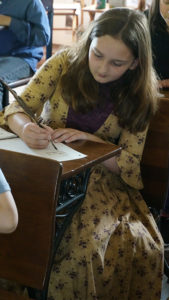
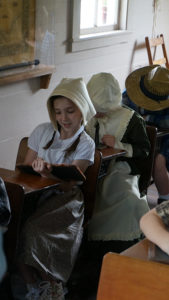 Children running about on the lawn of the small one room schoolhouse on Abbey Road in the Town of Richmond, NY seemed to cheer the small weathered building that has stood on the site since around 1875. The scene harkened back to those post-Civil War years, although there were telltale signs that we were in a different time. Interspersed among the period costumes were electric blue and high top sneakers. Still, as the children bent studiously over their desks working on small slate rectangles or dipping their feathers into inkwells, scrawling out the day’s message of “Waste Not, Want Not” again and again, one could imagine the earliest students.
Children running about on the lawn of the small one room schoolhouse on Abbey Road in the Town of Richmond, NY seemed to cheer the small weathered building that has stood on the site since around 1875. The scene harkened back to those post-Civil War years, although there were telltale signs that we were in a different time. Interspersed among the period costumes were electric blue and high top sneakers. Still, as the children bent studiously over their desks working on small slate rectangles or dipping their feathers into inkwells, scrawling out the day’s message of “Waste Not, Want Not” again and again, one could imagine the earliest students.
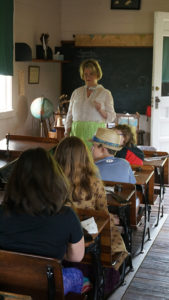 There were times when the differences between the students of the 19th century and the children before me seemed to fade even more. One of these times was recess, as students played jacks and rolled hoops across the freshly mowed lawn. The lines seemed to diminish also during the class fieldtrip to the Baker cemetery. Established in 1815, more than half a century before the school was built, its stones, many worn and fallen, serve as a reminder of those who came before – the relatives and later the aged students that first occupied the straight rows of desks. It also serves as a living historical classroom.
There were times when the differences between the students of the 19th century and the children before me seemed to fade even more. One of these times was recess, as students played jacks and rolled hoops across the freshly mowed lawn. The lines seemed to diminish also during the class fieldtrip to the Baker cemetery. Established in 1815, more than half a century before the school was built, its stones, many worn and fallen, serve as a reminder of those who came before – the relatives and later the aged students that first occupied the straight rows of desks. It also serves as a living historical classroom.
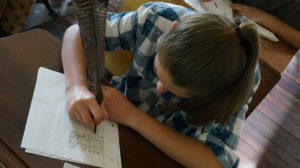 The cemetery field trip within a field trip and after lunch recess, along with classroom instruction, are part of a program for 4th grade students started by eight former teachers in 2003 (Jan Ashley, Gerry Barnard, Jane Barnard, Rita Carrier, Donna Cochrane, Marilyn Matteson, Carol MacDonald and Marcia Young). It is carried on today by other teachers, including Merrily Hoover, “Miss Mary,” and Cathy Campbell, “Miss Cathy.”
The cemetery field trip within a field trip and after lunch recess, along with classroom instruction, are part of a program for 4th grade students started by eight former teachers in 2003 (Jan Ashley, Gerry Barnard, Jane Barnard, Rita Carrier, Donna Cochrane, Marilyn Matteson, Carol MacDonald and Marcia Young). It is carried on today by other teachers, including Merrily Hoover, “Miss Mary,” and Cathy Campbell, “Miss Cathy.”
I attended school on Ma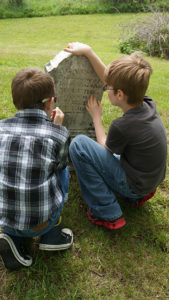 y 24th, and spent part of the day with Mrs. DeYoung’s 4th grade HCSD students. Two additional 4th grade classes attended later in the week: Mrs. Green’s class on May 25th and Mr. Nestrick’s class on May 26th.
y 24th, and spent part of the day with Mrs. DeYoung’s 4th grade HCSD students. Two additional 4th grade classes attended later in the week: Mrs. Green’s class on May 25th and Mr. Nestrick’s class on May 26th.
When I first arrived on the 24th, students were intently writing. All sat quietly at their desks, engaged and obedient. A few minutes later, following teacher instructions, the 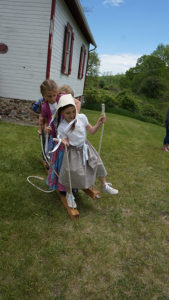 two rows left changed places with the two rows right, allowing all students to try writing on slates and using feather quills. When the lesson moved into math problems – “If one ton of hay costs $7. How much does 8 tons of hay cost?” – students raised their hands and, if called upon, stood beside their desks and provided their answers. Although I suspect it was the
two rows left changed places with the two rows right, allowing all students to try writing on slates and using feather quills. When the lesson moved into math problems – “If one ton of hay costs $7. How much does 8 tons of hay cost?” – students raised their hands and, if called upon, stood beside their desks and provided their answers. Although I suspect it was the 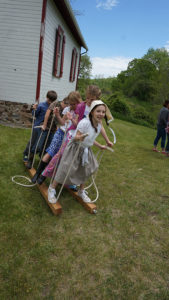 newness, the excitement, of being there, away from their normal classrooms, that contributed to this quiet order, the formality of the teachers for the day and, perhaps, the dunce cap that sat menacingly behind the teachers’ desk, may have played a role.
newness, the excitement, of being there, away from their normal classrooms, that contributed to this quiet order, the formality of the teachers for the day and, perhaps, the dunce cap that sat menacingly behind the teachers’ desk, may have played a role.
When the students headed up the hill to the Baker Cemetery, the energy changed. Students’ comments and actions showed that they recognized and respected the cemetery grounds and those who came before. They huddled over the stones, many fallen and some partially buried in the passing of time, and read the words solemnly. On the edge of one stone someone had picked and placed buttercup flowers in a neat row. Students stood in pairs or small groups and talked in hushed voices about life, and the realities of death. They were mature in their reflections, happy in the moment as they skipped about and explored all that the cemetery grounds had to offer – including the enticing holes dug by a family of groundhogs and the wheel barrow memorial to Herb Knight, who tended the cemetery grounds from 1919-2006.
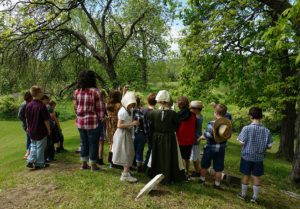 Returning to their classroo
Returning to their classroo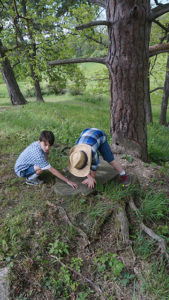 m, students sat still, waited their turn, as they were called a row at a time for lunch. They moved into the yard outside, thankful for the warm weather and sunshine that dominated the day. They settled into small clusters to enjoy their lunches, along with apple juice served up with a ladle into enameled cups.
m, students sat still, waited their turn, as they were called a row at a time for lunch. They moved into the yard outside, thankful for the warm weather and sunshine that dominated the day. They settled into small clusters to enjoy their lunches, along with apple juice served up with a ladle into enameled cups.
As sandwiches and apples were consumed, along with an assortment of packaged food items – another reminder of the present time – jittery students began to somersault across the lawn, initiating a period of recess that included 19th century toys. Diversions included shooting rocks with a slingshot, walking on parallel wooden beams, a task that required succinct coordinated movements, rolling hoops, stilt walking, ball and jacks and Jacob’s ladder.
Even during these times of play there was evidence of reflection, as students tried to understand the lives and experiences of the past. They are light years away from the school’s earliest students, who took their seats in school the same year as Alexander Graham Bell’s 1st telephone call, “Mr. Watson, “ he said to his assistant, “come here, I want to see you”. Abbey Road’s 19th century students, like the students of today, experienced great changes during their lives.
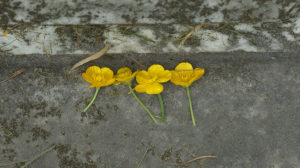 Moments of quiet reflection are now so rare, especially for young people. Yet these students – so accustomed to the digital world into which they all were born, acclimated to the fast paced lifestyle of the 21st century – paused for a day and understood – on a level deeper than any history book can offer – life as it was.
Moments of quiet reflection are now so rare, especially for young people. Yet these students – so accustomed to the digital world into which they all were born, acclimated to the fast paced lifestyle of the 21st century – paused for a day and understood – on a level deeper than any history book can offer – life as it was.
Story and photos by D.E. Bentley